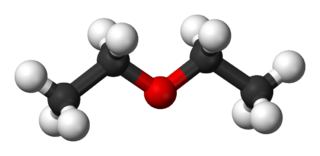
Ethers are a class of organic compounds that contain an ether group—an oxygen atom connected to two alkyl or aryl groups. They have the general formula R–O–R′, where R and R′ represent the alkyl or aryl groups. Ethers can again be classified into two varieties: if the alkyl groups are the same on both sides of the oxygen atom, then it is a simple or symmetrical ether, whereas if they are different, the ethers are called mixed or unsymmetrical ethers. A typical example of the first group is the solvent and anesthetic diethyl ether, commonly referred to simply as "ether" (CH3–CH2–O–CH2–CH3). Ethers are common in organic chemistry and even more prevalent in biochemistry, as they are common linkages in carbohydrates and lignin.
EtherType is a two-octet field in an Ethernet frame. It is used to indicate which protocol is encapsulated in the payload of the frame. The same field is also used to indicate the size of some Ethernet frames. EtherType was first defined by the Ethernet II framing standard, and later adapted for the IEEE 802.3 standard. This field is used by the data link layer to determine which protocol to hand over the payload to on the receiving end.
Dimethyl ether (DME, also known as methoxymethane) is the organic compound with the formula CH3OCH3, simplified to C2H6O. The simplest ether, it is a colorless gas that is a useful precursor to other organic compounds and an aerosol propellant that is currently being demonstrated for use in a variety of fuel applications. It is an isomer of ethanol.

William Thomas Green Morton was an American dentist who first publicly demonstrated the use of inhaled ether as a surgical anaesthetic in 1846. The promotion of his questionable claim to have been the discoverer of anaesthesia became an obsession for the rest of his life.

Diethyl ether, or simply ether, is an organic compound in the ether class with the formula (C
2H
5)
2O, sometimes abbreviated as Et
2O. It is a colorless, highly volatile flammable liquid. It is commonly used as a solvent in laboratories and as a starting fluid for some engines. It was formerly used as a general anesthetic, until non-flammable drugs were developed, such as halothane. It has been used as a recreational drug to cause intoxication.
Aether, æther or ether may refer to:
Petroleum ether is the petroleum fraction consisting of aliphatic hydrocarbons and boiling in the range 35‒60 °C; commonly used as a laboratory solvent. Despite the name, petroleum ether is not classified as an ether; the term is used only figuratively, signifying extreme lightness and volatility.
EtherCAT is an Ethernet-based fieldbus system, invented by Beckhoff Automation. The protocol is standardized in IEC 61158 and is suitable for both hard and soft real-time computing requirements in automation technology.
Methoxypropane, or methyl propyl ether, is an ether once used as a general anaesthetic. It is a clear colorless flammable liquid with a boiling point of 38.8 °C.
EtherNet/IP is an industrial network protocol that adapts the Common Industrial Protocol to standard Ethernet. EtherNet/IP is one of the leading industrial protocols in the United States and is widely used in a range of industries including factory, hybrid and process. The EtherNet/IP and CIP technologies are managed by ODVA, Inc., a global trade and standards development organization founded in 1995 with over 300 corporate members.

2-Arachidonyl glyceryl ether is a putative endocannabinoid discovered by Lumír Hanuš and colleagues at the Hebrew University of Jerusalem, Israel. It is an ether formed from the alcohol analog of arachidonic acid and glycerol. Its isolation from porcine brain and its structural elucidation and synthesis were described in 2001.

Flurothyl (Indoklon) is a volatile liquid drug from the halogenated ether family, related to inhaled anaesthetic agents such as diethyl ether, but having the opposite effects, acting as a stimulant and convulsant. A clear and stable liquid, it has a mild ethereal odor whose vapors are non-flammable. It is excreted from the body by the lungs in an unchanged state.

Silandrone, also known as testosterone 17β-trimethylsilyl ether or 17β-trimethylsilyltestosterone, as well as 17β-(trimethylsiloxy)androst-4-en-3-one, is a synthetic anabolic-androgenic steroid (AAS) and an androgen ether – specifically, the 17β-trimethylsilyl ether of testosterone – which was developed by the G. D. Searle & Company in the 1960s but was never marketed. It has a very long duration of action when given via subcutaneous or intramuscular injection as well as, notably, significantly greater potency than that of testosterone propionate. In addition, it is notable that silandrone, unlike testosterone and most esters of testosterone like testosterone propionate, is orally active.

Quinestradol, also known as quinestradiol or quinestriol, as well as estriol 3-cyclopentyl ether (E3CPE), is a synthetic estrogen and estrogen ether which is no longer marketed. It is the 3-cyclopentyl ether of estriol. The medication has been studied in the treatment of stress incontinence in elderly women, with effectiveness observed.

Methyltestosterone 3-hexyl ether, or 17α-methyltestosterone 3-hexyl enol ether, also known as 17α-methylandrost-3,5-dien-17β-ol-3-one 3-hexyl ether, is a synthetic anabolic-androgenic steroid and an androgen ether – specifically, the 3-hexyl ether of methyltestosterone.

Progesterone 3-acetyl enol ether, also known as progesterone acetate, as well as 3-acetoxypregna-3,5-dien-20-one, is a progestin which was never marketed. It was reported to possess similar potency to progesterone and hydroxyprogesterone caproate in the rabbit endometrial carbonic anhydrase test, a bioassay of progestogenic activity. In addition, it was able to maintain pregnancy in animals. Progesterone 3-acetyl enol ether is closely related to quingestrone, which is also known as progesterone 3-cyclopentyl enol ether and was formerly marketed as an oral contraceptive.

Estrone methyl ether, or estrone 3-methyl ether, is a synthetic estrogen and estrogen ether – specifically, the C3 methyl ether of estrone – which was never marketed. It has been used to synthesize mestranol.










